Cirrus SR22
The Cirrus SR22 is a single-engine four- or five-seat composite aircraft built from 2001 by Cirrus Aircraft of Duluth, Minnesota.
| SR22 | |
|---|---|
 | |
| Cirrus SR22 G3 | |
| Role | Civil utility aircraft |
| National origin | United States |
| Manufacturer | Cirrus Aircraft |
| Produced | 2001–present |
| Number built | 6,149 through 2019[1][2] |
| Developed from | Cirrus SR20 |
It is a development of the Cirrus SR20, with a larger wing, higher fuel capacity, and a more powerful, 310-horsepower (231 kW) engine.
The SR22 series has been the world's best-selling general aviation (GA) airplane every year since 2003. With 6,149 units delivered from 2001–19, and in combination with the SR20, a total of 7,645, it is the most-produced GA aircraft of the 21st century, and is the single most-produced GA aircraft made from composite material, accounting for over 30% of the entire piston aircraft market.[1][2][3]
The Cirrus SR22 is equipped with a whole-plane emergency recovery parachute system: the Cirrus Airframe Parachute System (CAPS). This has contributed to its market success and has given it the nickname "the plane with the parachute".[4][5][6][7][8]
Design and development

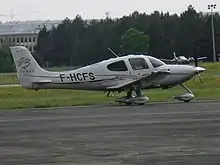
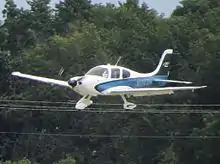
The SR22, certified in November 2000, is a more powerful version of the earlier SR20. Production of the aircraft started in 2001. The SR22 is a low-wing cantilever monoplane of composite construction, featuring fixed (non-retractable) tricycle landing gear with a castering nose wheel and steering via differential braking on the main wheels. It is powered by a nose-mounted 310 hp (231 kW) Continental IO-550-N piston engine. The four-seat cabin is accessed through doors on either side of the fuselage.
The SR-series remains the only production airplane in its class to include side stick flight controls that combine aspects of a traditional yoke handle (referred to in the industry as a "side yoke").[8]
The Cirrus SR22, like the SR20, is equipped with the Cirrus Airframe Parachute System (CAPS), which can lower the entire aircraft to the ground relatively gently in an emergency.[9]
In 2004, the company introduced the SR22 G2 (Generation 2) and in 2007 the SR22 G3 (Generation 3). Both were defined by airframe modifications, G2 by fuselage and G3 by modified wing and landing gear.
In a 2012 Flying magazine review, then editor-in-chief Robert Goyer[N 1] wrote that the Cirrus SR22 "is the most sophisticated single-engine civilian airplane ever built and by a long shot."[11]
In 2013, the manufacturer introduced the SR22 G5 (Generation 5) (there was no G4). Key changes were an increase in gross weight to 3,600 lb (1,633 kg) and a standard five-seat cabin arrangement.[12] The G5 received only minor changes for 2014, including integrated LED lighting and Beringer brakes.[13][14]
In 2014, the SR22 and SR22T had been the best-selling four-to-five-seat fixed-wing aircraft in the world for 12 years in a row.[15][16]
In 2016, Cirrus introduced improvements to the SR Series, including Bluetooth wireless connectivity, a remote keyless entry, convenience lighting system, and an easy-access door latch.[17][18]
In 2017, the company introduced the SR22 G6 (Generation 6), with several major upgrades to the avionics and new navigation lighting.[19][20]
In September 2019, Cirrus unveiled the TRAC, a training-oriented version of the SR-series with a simplified interior, more durable seat material, backseat radio transmit switch to allow an observer to communicate with air traffic control, integrated engine indication and crew alerting/warning systems, and simulated retractable landing gear controls and position lights to allow cadets and instructors to feign landing gear operation and failures during instructional flights (the actual landing gear remains permanently fixed).[21][22]
In January 2020, the company introduced a new mobile app for the SR Series, called "Cirrus IQ", which enables remote aircraft communication including access to pre-flight status information like fuel and oxygen levels, battery voltage, oil temperature, aircraft location and flight hours.[23]
Turbocharged models
Cirrus introduced the SR22 Turbo in 2006, with a Tornado Alley turbonormalizing upgrade kit that is factory installed under a Supplemental Type Certificate. It included twin turbonormalizers and twin intercoolers.[24] The conversion includes built-in oxygen and a Hartzell three-blade (later four-blade as optional[23]) lightweight composite propeller. The weight of the conversion reduces the SR22's useful load. Air conditioning is available with the SR22 Turbo, but this further reduces the useful load. The turbo version has a certified ceiling of 25,000 feet (7,600 m), a maximum cruise speed of 211 knots (391 km/h), and a top speed of 219 knots (406 km/h).[25][26][27]
In 2010, Cirrus introduced the SR22T. This used a new engine, the Continental TSIO-550K, which produces 315 hp (235 kW) with a 7.5:1 compression ratio and can run on 94 octane fuel.[28]
Glass cockpit
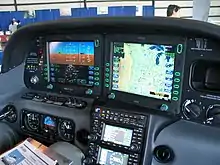
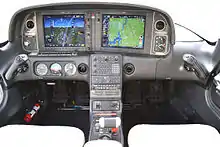
SR22s and SR20s built before 2003 were equipped with traditional analog instruments and a 10" (later 12") Multi-function display (MFD). In February 2003, Cirrus began offering SR22s with the Avidyne Entegra primary flight display (PFD), making the plane the first of its kind to come with a glass cockpit.[29] Later that year, this instrumentation became standard equipment on all SR-series aircraft and sparked a major transition in general aviation, whereby over 90% of all new light aircraft by the year 2006 were equipped with glass cockpits.[30][31] Retrofits are available for the older SR aircraft that replace the analog instrument panels with one that includes a PFD, a new MFD and the installation of back-up mechanical instruments.[32]
On 22 May 2008, Cirrus revealed the "Cirrus Perspective" glass cockpit (by Garmin).[33] Both cockpits were available for a while (the Avidyne cockpit was initially standard equipment) and after 2008 the SR22 was sold with only the Perspective panel.
In 2009, the third-generation Cirrus SR22 GTS came equipped with a new enhanced vision system (EVS), a sophisticated dual-wavelength instrument that offers both infrared and synthetic vision.[34]
At the 2010 EAA AirVenture, Cirrus announced its plans to certify Garmin's ESP system (Electronic Stability and Protection) on the Cirrus SR22. It included advanced flight envelope protection that could stabilize the aircraft with the push of a button, to avoid spiral from developing.[35]
The Cirrus Perspective-Plus avionics flight deck was introduced in 2017, with a faster processing speed, animated datalink weather, payload management, visual approach capabilities, wireless database uploads, glass back-up instruments, and more.[36]
In 2020, the Perspective-Plus flight deck included a new stabilized approach advisory system which provides alerts to the pilot of unstable conditions during approach.[23]
Flight into known icing
Cirrus completed testing for flight into known icing conditions (FIKI) on 12 January 2009. The equipment change involved installing a larger fluid tank for the TKS Ice Protection System and protecting more areas of the aircraft. The FAA approved the new installation in April 2009.[37][38][39]
Operational history
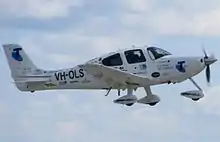
Australian pilot Ryan Campbell used an SR22 to become the youngest pilot to fly solo around the world (a title which he held for nearly a year), at age nineteen. He completed his trip on 7 September 2013 in Wollongong. His SR22, Spirit of the Sapphire Coast, was modified by removing three seats and adding a 160 U.S. gallons (610 L; 130 imp gal) fuselage tank for a total of 250 U.S. gallons (950 L; 210 imp gal) usable.[40][41]
As of September 2018, the SR-series has deployed the parachute system 79 times carrying 163 survivors.[42]
Variants
%252C_Luxembourg_PP1276003150.jpg.webp)
%252C_Luxembourg_PP1373043529.jpg.webp)
- SR22
- Original version
- SR22 G2
- Improved variant
- SR22 Turbo G2
- In July 2006, Cirrus announced a turbo normalized SR22. Some initial limited models were identified as Signature Edition SE22 G2s—equipped with additional features including an unequally painted exterior, black leather seats, and the signatures of Cirrus founders Dale and Alan Klapmeier on the cowling.[43]
- SR22TN
- Version with a Tornado Alley turbo-normalizing kit added to the Continental IO-550-N engine producing 310 hp (231 kW).[44]
- SR22 G3
- Launched in April 2007, the SR22 G3 variant has an increased fuel capacity from 81 to 92 U.S. gallons (310 to 350 L; 67 to 77 imp gal), a lighter stronger carbon fiber wing spar and longer landing gear for increased prop clearance.[45] Upgraded models, such as the GTS, come with airbag seatbelts.[46]

- SR22T
- Introduced in June 2010, with a turbocharged Continental TSIO-550-K producing 315 hp (235 kW). The engine has low-compression pistons, producing a 7.5 to 1 compression ratio to allow the engine to run on lower octane fuel, 94UL.[44][47][48] The SR22T has a maximum cruise speed of 214 kn (396 km/h), empty weight of 2,348 lb (1,065 kg), and a maximum operating altitude of 25,000 ft (7,620 m). This model also has a decreased useful load of 1,052 lb (477 kg) and reduced range of 1,046 nmi (1,937 km),[49] as well as a Hartzell three-blade lightweight composite prop.[50]
- SR22/22T G5
- On 17 January 2013, Cirrus Aircraft announced the fourth generation of the SR22 and SR22T (skipping G4 as a designation for the new version of the aircraft). Features included a 200 lb (91 kg) increase in the maximum takeoff weight, and some previous options—60/40 split back seat, ADS-B transponder, and Garmin GFC700 autopilot—became standard equipment. The wheel pants were redesigned and included an access door for the inflator valve. Cirrus improved the aircraft's ballistic parachute using a larger canopy to account for the higher takeoff weight, and a more powerful rocket. The rocket firing changed to a fail-safe electronic ignition, with a maximum operating speed of 140 knots (up from 133 knots). Earlier versions used a pyrotechnic rocket ignition system. Maximum flap speeds were increased to 150 knots (first notch); 110 knots (second notch); and added another 3.5 degrees of extension. Fuel burn slightly increased at cruise speeds, rate of climb was reduced, liftoff speed increased to 80 knots (from 72 knots), and stall speed increased to 60 knots (from 58 knots).[51][52]
- SR22/22T G6
- Introduced in January 2017, the G6 model adds new LED wingtip lights and an updated Garmin avionics flight deck (known as "Cirrus Perspective-Plus") with a 10-times faster instrument processing speed and several other upgrades.[36]
- TRAC
- Introduced in September 2019, the TRAC is a flight-training version SR22/22T with a simplified, more durable interior, Perspective+ flight deck, rear seat push-to-talk functionality, and simulated landing gear controls.[21][22]
Operators
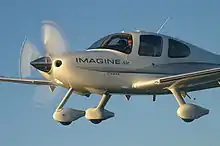
The aircraft is used by flying schools, air charter and small air taxi carriers as well as private individuals and companies. For several years, the largest fleet was operated by ImagineAir, which was in operation from 2007–2018. Previously to this, the largest fleet—26 aircraft—had been operated by SATSair, which began operations in 2004 and went out of business in 2009. The largest European operator of the Cirrus SR22 is Fly Aeolus, a Belgian fractional ownership company established in 2009 that operates 13 SR22s.[53][54][55]
The French Air and Space Force uses six SR22s as training aircraft,[56] and the Royal Saudi Air Force acquired 25 SR22s in 2013, replacing Cessna 172s as primary trainers at the King Faisal Air Academy.[57] In 2015 Emirates purchased 22 aircraft for training purposes.[58] The Minnesota State Patrol uses a special missions "Cirrus Perception" SR22 for law enforcement operations, surveillance, search and rescue missions and more.[59][60][61]
Accidents and incidents
Between 2001 and May 2014, 147 US-registered Cirrus SR22 aircraft crashed, resulting in 122 fatalities.[62]
In 2011, the accident record of the SR20/SR22 was examined by Aviation Consumer magazine. It found that the series' overall accident record is better than average for light aircraft, exceeded only by the Diamond DA40 and DA42. However its fatal accident rate is worse, at 1.6 per 100,000 flight hours—which places it higher than the United States general aviation rate of 1.2, and higher than the Diamond DA40 (0.35), Cessna 172 (0.45), Diamond DA42 (0.54), Cessna 182 (0.69), and the Cessna 400 (1.0), despite the SR22's full aircraft parachute system.[63]
By the end of 2013, the accident rate had been reduced to a fatality rate of 1.01 per 100,000 flight hours. This was attributed to better training, particularly in use of the ballistic parachute system.[64]
The accident rate continued to decrease in 2014, with a fatal rate of .42 per 100,000 flight hours, one of the industry's lowest. This marked the fewest fatalities in a single year for Cirrus since 2001, and the first year where the number of CAPS deployments (12) exceeded the number of fatal accidents (3).[4][65][66]
Specifications (SR22-G5)

.jpg.webp)
Data from Cirrus website[67] and The Incomplete Guide to Airfoil Usage[68]
General characteristics
- Crew: one
- Capacity: four passengers
- Length: 26 ft 0 in (7.92 m)
- Wingspan: 38 ft 4 in (11.68 m)
- Height: 8 ft 11 in (2.72 m)
- Airfoil: Roncz
- Empty weight: 2,269 lb (1,029 kg)
- Gross weight: 3,600 lb (1,633 kg)
- Fuel capacity: 92 US gallons (348 litres)
- Powerplant: 1 × Continental IO-550-N Six cylinder horizontally opposed aircraft engine, 310 hp (230 kW)
- Propellers: 3-bladed
Performance
- Cruise speed: 183 kn (211 mph, 339 km/h)
- Stall speed: 60 kn (69 mph, 110 km/h) flaps down
- Range: 1,049 nmi (1,207 mi, 1,943 km) with reserves at 65% power
- Service ceiling: 17,500 ft (5,300 m)
- Rate of climb: 1,270 ft/min (6.5 m/s)
Avionics
See also
Related development
- Cirrus SR20
- Cirrus Vision SF50 (fanjet)
Aircraft of comparable role, configuration, and era
References
- "2007 General Aviation Statistical Databook & Industry Outlook" (PDF). General Aviation Manufacturers Association. January 2008. Archived from the original (PDF) on 7 November 2017. Retrieved 2 July 2010.
- General Aviation Manufacturers Association (2020). "2019 Databook" (PDF). Archived (PDF) from the original on 20 February 2020. Retrieved 1 March 2020. Cite journal requires
|journal=(help) - Rapoport, Geoff (22 February 2017). "GAMA 2016 Year-End Report: Piston Sales Flat, Turbine Single And Cirrus Sales Up". AVweb. Archived from the original on 26 February 2017. Retrieved 31 October 2017.
- Anders, Clark (22 May 2015). "Cirrus SR22: The Plane with the Parachute". Disciples of Flight. Archived from the original on 13 June 2015. Retrieved 11 June 2015.
- "Smart Safety". Cirrus aircraft. Archived from the original on 18 October 2015. Retrieved 2 November 2015.
- Fallows, James (January 2015). "The Parachute That Saved a Plane". The Atlantic. Archived from the original on 27 January 2015. Retrieved 2 November 2015.
- Goyer, Robert (August 2010). "After Ten Years, Cirrus Chute Controversy Persists". Flying. Archived from the original on 26 October 2014. Retrieved 2 November 2015.
- Robert Goyer (2011). "10 Ways that the SR22 Changed Flying". Flying. Archived from the original on 3 November 2015. Retrieved 2 November 2015.
- Federal Aviation Administration (May 2008). "TYPE CERTIFICATE DATA SHEET NO. A00009CH Rev. 13" (PDF). Archived from the original (PDF) on 19 February 2009. Retrieved 14 October 2008.
- "Name Change At Plane & Pilot". Plane & Pilot. 28 August 2018. Retrieved 18 December 2020.
- "2012 Cirrus SR22". Archived from the original on 31 October 2015. Retrieved 26 December 2015.
- "Cirrus Aircraft". Cirrus Aircraft. Archived from the original on 15 January 2010. Retrieved 29 May 2013.
- "The All-New 2014 Generation 5 Cirrus". October 2013. Archived from the original on 13 October 2013. Retrieved 16 November 2013.
- Goyer, Robert (October 2013). "New Cirrus SR22s Introduced for 2014". Archived from the original on 18 November 2013. Retrieved 16 November 2013.
- Durden, Rick (21 February 2014). "2013: A Good Year for Cirrus". AVweb. Archived from the original on 10 October 2014. Retrieved 24 February 2014.
- Cirrus Aircraft News (11 February 2015). "Cirrus Aircraft Deliveries in 2014 Drive Strongest Performance in Six Years". Archived from the original on 15 February 2015. Retrieved 1 March 2015.
- "Cirrus Aircraft 2016 SR Series Introduction". Vimeo.com. January 2016. Archived from the original on 10 August 2016. Retrieved 10 June 2016.
- Cirrus Aircraft News (16 February 2016). "Cirrus Aircraft Unveils Enhanced 2016 SR Series". Archived from the original on 24 June 2016. Retrieved 10 June 2016.
- Goyer, Robert (January 2017). "G6: We Fly it First". Plane & Pilot. Archived from the original on 22 January 2017. Retrieved 16 February 2016.
- Pope, Stephen (January 2017). "Cirrus Launches New Generation of SR-Series Piston Singles". Flying. Archived from the original on 6 January 2017. Retrieved 16 January 2016.
- Hirschman, Dave (24 September 2019). "Making Better Pro Pilots Faster: New TRAC Trainer from Cirrus". aopa.org. Aircraft Owners and Pilots Association. Archived from the original on 27 September 2019. Retrieved 27 September 2019.
- Mark, Rob (25 September 2019). "Cirrus Unveils TRAC Series of Flight Training Aircraft". flyingmag.com. Flying. Archived from the original on 27 September 2019. Retrieved 27 September 2019.
- Aviation Pros (January 2020). "Cirrus Aircraft Launches the 2020 SR Series Powered by an All-New Mobile App". Archived from the original on 8 January 2020. Retrieved 7 January 2020.
- Cirrus Design (2007). "SR22 features & options". Archived from the original on 6 November 2007. Retrieved 14 November 2007.
- Cirrus Design (2007). "SR22 performance". Archived from the original on 6 November 2007. Retrieved 14 November 2007.
- Cirrus Design (2007). "Turbo normalizing". Archived from the original on 7 November 2007. Retrieved 14 November 2007.
- Cirrus Design (2007). "The speed you need". Archived from the original on 7 November 2007. Retrieved 14 November 2007.
- Cox, Bill (20 July 2010). "Cirrus SR22T: Turbo Without the STC". Plane & Pilot. Archived from the original on 15 April 2012. Retrieved 3 March 2012.
- Media Fly-By. "Cirrus Soars at First Flight Celebration". Archived from the original on 14 July 2014. Retrieved 2 February 2015.
- National Transportation Safety Board. "Introduction of Glass Cockpit Avionics into Light Aircraft" (PDF). Archived (PDF) from the original on 5 September 2015. Retrieved 11 September 2015.
- Press Release (2003). "Avidyne's Flightmax Entegra Integrated Flight Deck Selected By Cirrus Design For SR20 And New SRV Aircraft". Retrieved 8 September 2015.
- Goyer, Robert: Avidyne Glass for Steam Gauge Cirrus Airplanes, Flying magazine February 2008, pp. 18–19. Hachette Filipacchi US Media
- Cirrus Design (2008). "Cirrus Perspective by Garmin". Archived from the original on 7 January 2009. Retrieved 25 October 2008.
- John Croft (2009). "The Third Generation Cirrus SR22 is Blazing a Trail". Archived from the original on 15 October 2014. Retrieved 9 October 2014.
- Robert Goyer (2010). "Envelope Protection Comes to GA". Archived from the original on 22 August 2014. Retrieved 19 October 2014.
- Grady, Mary (4 January 2017). "Cirrus Updates SR22 And SR20". AVweb. Archived from the original on 6 January 2017. Retrieved 6 January 2017.
- Niles, Russ (January 2009). "Cirrus Introduces FIKI, Announces Layoffs". Archived from the original on 3 March 2016. Retrieved 12 January 2009.
- Cirrus Design (January 2009). "Cirrus Aircraft Announces Known Ice Protection Availability For SR22 And Turbo Aircraft Models". Archived from the original on 8 July 2011. Retrieved 12 January 2009.
- Grady, Mary (April 2009). "Cirrus Announces FAA OK For FIKI System, Update on Jet". Archived from the original on 12 June 2011. Retrieved 13 April 2009.
- "Ryan Campbell world record attempt". Archived from the original on 11 September 2013. Retrieved 2 September 2013.
- "Teen makes youngest round-the-world solo flight". Archived from the original on 13 October 2016. Retrieved 28 June 2017.
- Cirrus Owners and Pilots Association (12 October 2018). "Cirrus CAPS History". Archived from the original on 13 October 2018. Retrieved 12 October 2018.
- Grady, Mary (December 2006). "Aviation: Pilot Program". Archived from the original on 18 May 2015. Retrieved 30 January 2015.
- Bertorelli, Paul (June 2010). "Cirrus Rolls Out a New Turbocharged Model". Archived from the original on 21 June 2010. Retrieved 21 June 2010.
- Cirrus Design (2008). "G3 What's New". Archived from the original on 29 March 2008. Retrieved 20 September 2007.
- "Airbags in the SR22". AOPA. Archived from the original on 6 December 2017. Retrieved 13 November 2016.
- Van West, Jeff (June 2010). "Cirrus' New Turbo: Baffling". Archived from the original on 26 June 2010. Retrieved 24 June 2010.
- "Aviation Fuel Future". Archived from the original on 14 July 2012. Retrieved 3 July 2012.
- "Cirrus Designs SR22 Turbo Specifications". Archived from the original on 27 June 2011. Retrieved 16 July 2011.
- "SR22T Price Sheet" (PDF). Archived from the original (PDF) on 14 December 2010. Retrieved 16 July 2011.
- "Cirrus Launches Generation 5 SR22". Archived from the original on 20 January 2013. Retrieved 17 January 2013.
- "Generation 5 Cirrus SR22". Archived from the original on 28 August 2013. Retrieved 17 May 2013.
- Sarsfield, Kate (7 November 2018). "Fly Aeolus prepares for expansion". Flightglobal.com. Archived from the original on 15 December 2018. Retrieved 11 December 2018.
- Imagine Air Jet Services (2005). "Company Background". Archived from the original on 15 November 2009. Retrieved 4 November 2009.
- Niles, Russ (October 2009). "SATSAir Shuts Down". Archived from the original on 27 October 2009. Retrieved 26 October 2009.
- "Les avions et hélicos de l'Armée de l'Air en 2015". avionslegendaires.net. 25 December 2015. Archived from the original on 16 January 2017. Retrieved 10 November 2016.
- "Saudi SR22s". Air International. Vol. 85 no. 4. October 2013. p. 22. ISSN 0306-5634.
- Pope, Steven (November 2015). "Emirates Selects Cirrus SR22 for Pilot Training". Archived from the original on 20 August 2020. Retrieved 12 November 2015.
- "Cirrus Aircraft Unveils New Special Mission Platform". July 2016. Archived from the original on 24 December 2016. Retrieved 18 June 2017.
- Connley, Courtney (3 June 2017). "Lost paddlers in Minnesota write 'SOS' in the sand to help rescuers find them". ABC News. Archived from the original on 22 June 2017. Retrieved 18 June 2017.
- Blotz, Tim (14 June 2017). "State Patrol unveils airplane used to track aggressive drivers". Fox 9. Archived from the original on 18 June 2017. Retrieved 18 June 2017.
- NTSB (2014). "NTSB Database & Synopses-Query". Archived from the original on 21 June 2014. Retrieved 10 May 2014. Nb.-Make=Cirrus, Model=SR22, Registration="N" (US only)
- "Aviation Consumer: Cirrus Safety Record Just Average". AVweb. 20 December 2011. Archived from the original on 9 January 2012. Retrieved 22 December 2011.
- Bertorelli, Paul (10 April 2014). "Cirrus Reports Dramatic Accident Reduction". Avweb. Archived from the original on 13 April 2014. Retrieved 14 April 2014.
- Zimmerman, John (11 February 2015). "Fatal Cirrus crashes are way down – thank the parachute". Air Facts. Archived from the original on 13 June 2015. Retrieved 11 June 2015.
- Beach, Rick (1 July 2014). "Mid-Year 2014 Update on Improved Cirrus accident rates". Cirrus Owners and Pilots Association. Archived from the original on 12 June 2015. Retrieved 11 June 2015.
- Cirrus Design. "Specifications". Archived from the original on 15 January 2010. Retrieved 16 January 2010.
- Lednicer, David (October 2007). "Incomplete Guide to Airfoil Usage". Archived from the original on 15 May 2008. Retrieved 15 January 2010.
- "Pilot's Guide for the Cirrus SR20/SR22/SR22T" (PDF). Garmin. 2014. Archived (PDF) from the original on 2 April 2015. Retrieved 28 February 2015.
Notes
- Goyer changed her name in 2018 to Isabel and has been editor-in-chief of Plane & Pilot since 2016.[10]
External links
| Wikimedia Commons has media related to Cirrus SR22. |
- Official website
- Lee, Henry (26 January 2015). "Video shows plane using parachute to ditch into ocean near Maui". San Francisco Chronicle. Retrieved 28 January 2015.
